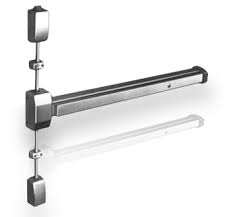 Electronic locks are becoming increasingly commonplace in today’s market. While they carry a host of features and benefits, they are not without their unique set of installation and troubleshooting issues.
Electronic locks are becoming increasingly commonplace in today’s market. While they carry a host of features and benefits, they are not without their unique set of installation and troubleshooting issues.
We install and service a large number of Surface Vertical Rod, or SVR Exit Devices with Motorized Latch Retraction. A common issue we hear about is that the bar will skip or jump when power is applied to the unit. This means that along with the annoying noise, the only way to use the device is to manually engage it. This defeats the entire purpose of motorized latch retraction.
There are also instances where the device will jam up entirely and will not engage either manually or with power.
So, a common question we are asked by customers and technicians alike is:
“What is causing my SVR motorized exit device to fail and how can I fix it?”
SVR Exit Device Malfunctions – The Culprits
Rod Length is Too Long – Jumping Bars
Rod length is the most likely culprit of a jumping or skipping bar.
The reason this is such a common problem is because the device will operate just fine mechanically, and often times, the device is installed prior to electricity being run to the device. As such, unless the installer has a way to apply electricity to the device during the installation, this symptom won’t present itself.
If the bar is jumping, check to see if the top rod is too long. If the top rod is too long, the motor can’t fully engage the mechanism to keep the unit in an unlocked state. Check out this troubleshooting video for a step-by-step demonstration.
Rod Length is Too Short – Unable to Exit
If your top rod is too short, you will not be able to open the door either mechanically or when power is applied to the device. This is because the rod won’t allow the latch to fully extend into the latch pocket.
If the door is not opening, check to see if the top rod is too short. Check out the latter part of the above troubleshooting video for more guidance.
Improper Screws – Binding Unit
Believe it or not, something as simple as using the wrong length or shape of screw can cause your device to bind. When putting on any of the covers, if the screws are too long, they will sandwich the rod and cause it to bind.
Likewise, when installing the top latch, if the wrong shape of screw head is used, it will protrude and rub against the back of the rod.
If screws are causing an issue, you will likely see signs of wear on the rod where the screws are installed. If your rod is binding, be sure to inspect it closely for scratches or grooves and refer to the installation instructions to ensure that the proper screws are used.
